Gulfstream V
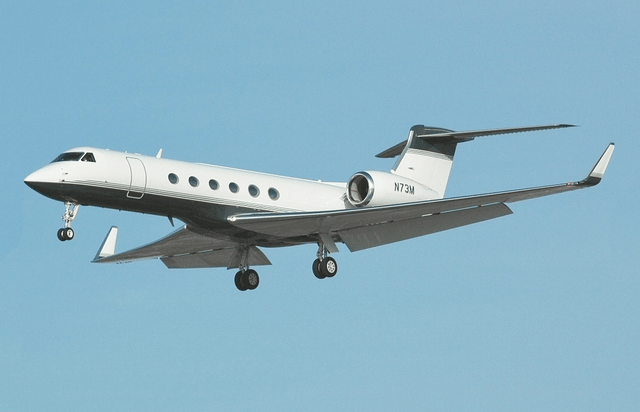
Gulfstream V

| Gulfstream V C-37A | |
|---|---|
| Role | Business jet |
| National origin | United States |
| Manufacturer | Gulfstream Aerospace |
| First flight | November 28, 1995[1] |
| Introduction | June 1997[1] |
| Status | In service |
| Primary users | United States Air Force United States Coast Guard United States Navy |
| Number built | 193[2] |
| Unit cost | $36 million (1998)[3] |
| Developed from | Gulfstream IV |
| Variants | Gulfstream G550 |
The Gulfstream V (Model GV, pronounced "G-five") is a long-range, large business jet aircraft produced by Gulfstream Aerospace, derived from the previous Gulfstream IV. It flies up to Mach 0.885, up to 51,000 feet (16,000 m) and has a 6,500 nautical miles (12,000 km) range. It typically accommodates four crew and 14 passengers. It first flew on November 28, 1995, and entered service in June 1997.[1] It is used by the US military under the designation C-37A.[4] It is followed by an improved version, the Gulfstream 550 (Model GV-SP).
| Gulfstream V C-37A | |
|---|---|
| Role | Business jet |
| National origin | United States |
| Manufacturer | Gulfstream Aerospace |
| First flight | November 28, 1995[1] |
| Introduction | June 1997[1] |
| Status | In service |
| Primary users | United States Air Force United States Coast Guard United States Navy |
| Number built | 193[2] |
| Unit cost | $36 million (1998)[3] |
| Developed from | Gulfstream IV |
| Variants | Gulfstream G550 |
Development
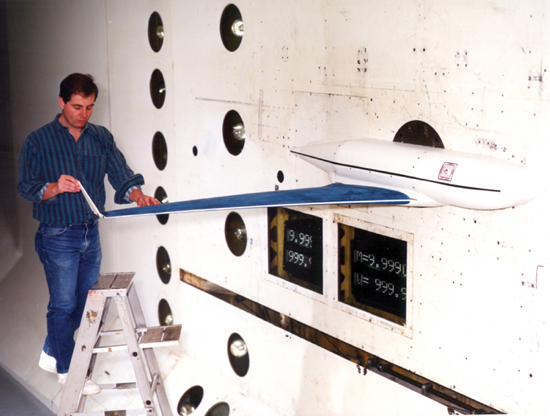
Model in wind tunnel
In the early 1990s, the Gulfstream V (GV) was developed as a response to the Bombardier Global Express.[5] It was certified on April 11, 1997.[6] Capable of flying up to 6,500 nmi (12,000 km), it rolled out in 1995 and was Gulfstream's first ultra-long range business jet. Total production of the Gulfstream V was 193 aircraft.[2] By 2018, 1997-1999 Gulfstream GVs were trading at $8.8-10.25 million.[7] By 2019, a GV was worth around $10 million: below $6 million for a fixer to less than $13 million for a late model low-time aircraft.[5]
Design
Compared to the Gulfstream IV, the engines are changed from Rolls-Royce Tay to Rolls-Royce BR700-710A1-10 with increased thrust, higher bypass ratio, and Full Authority Digital Engine Controls (FADEC). Operating ceiling is increased from 45,000 ft to 51,000 ft. It has thrust reversers and composite flight control surfaces. The horizontal tail area is 30% larger, wingspan is increased from 74.6 ft to 93.5 ft, the fuselage is lengthened by 5 foot forward of the main entry door, and by 2 foot aft of the wing. Maximum takeoff and landing weights are increased by 15%.[6]
It has a new semi supercritical wing for a fuel capacity of 41,000–12,000 lb (18.6–5.4 t) more than the G-IV. The three zone cabin is similar to the G-IV, smaller than the Global Express, while its dispatch reliability, cabin noise and fuel efficiency compare favourably against its competitors of the same era. Compared to the comparably priced Global Express, the GV offers more range and is more fuel efficient while the Bombardier offers better runway performance, a larger cabin and a softer ride. BR710 overhaul comes at 8,000 hour or 10 years if it comes earlier and costs $1.25 million per engine.[5]
U.S. Air Force C-37A
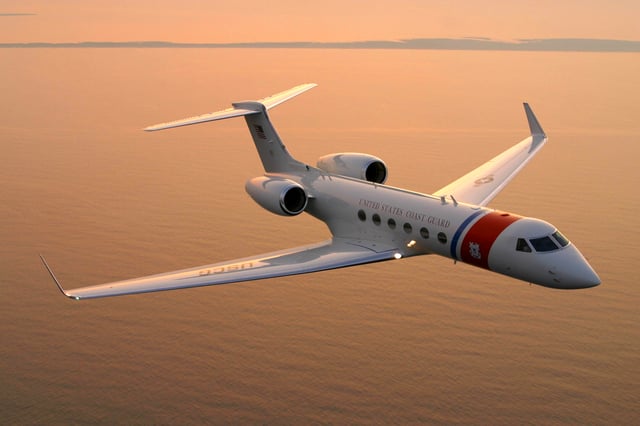
USCG C-37A in flight
Designated C-37A in U.S. Air Force service, the Gulfstream V is used by United States government and Defense Department officials. The US Coast Guard operates two C-37A for transportation of the Secretary of Homeland Security and the Commandant of the Coast Guard. The US Navy operates one C-37A.
The aircraft has a flight management system with a GPS receiver. The C-37A is capable of cruising at 51,000 feet (16,000 m). Features include enhanced weather radar, autopilot and head-up display for the pilot. Safety features include Enhanced Vision Systems that allows increased visibility in adverse environments. The aircraft is also equipped with commercial and military communications equipment to provide secure voice and data capability. The U.S. Air Force equips the C-37A with a basic crew of two pilots, one flight engineer, one communications systems operator, and one flight attendant. It accommodates 5 crew and 12 passengers.[3]
Operators
Civil operators
The majority of G-Vs are operated by corporate and individual owners. Mark Cuban paid $40 million for a Gulfstream V in October 1999, earning a Guinness Record of "largest single e-commerce transaction". Steve Jobs received a Gulfstream V as compensation from Apple in 2000.[8]
Government and military operators
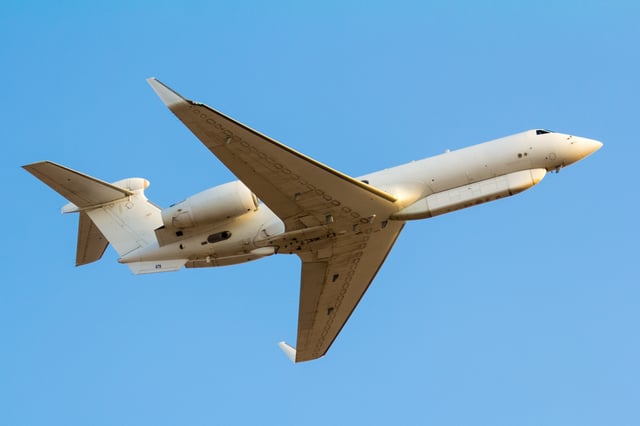
Israeli SEMA Gulfstream G550 inflight
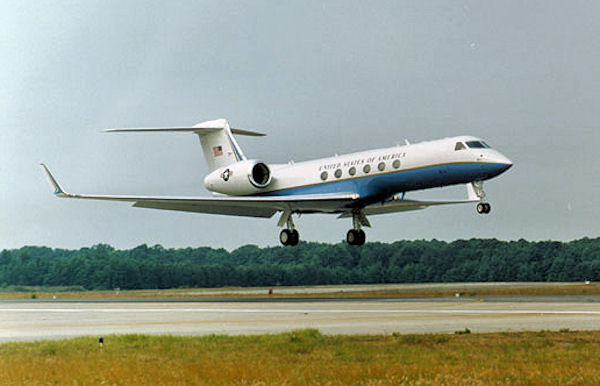
U.S. Air Force C-37A in VIP livery
Algeria
Algerian Air Force operates the Gulfstream V for VIP transport
Hellenic Air Force operates one Gulfstream V for VIP transport.
A Special Electronic Mission Aircraft (SEMA), based on a highly modified Gulfstream G-V aircraft, was delivered to the Israeli Ministry of Defense in June 2005.[9]
Japan Coast Guard received the first of two G-Vs on January 17, 2005.[10] Dubbed "Umi Washi" (Sea Eagle), the aircraft will be operated by the JCG for maritime surveillance search and rescue. The second aircraft was delivered in mid-2005.
The State of Kuwait operates a G-V aircraft[11] in a transport role for the Royal family.
Saudi Arabia operates two GVs in a medevac configuration.[12]
The 89th Airlift Wing's 99th Airlift Squadron, Andrews Air Force Base, Maryland, operates four C-37As. The 6th Air Mobility Wing's 310th Airlift Squadron, MacDill Air Force Base, Florida operates three C-37As. The 15th Airlift Wing's 65th Airlift Squadron, Hickam Air Force Base, Hawaii operates one C-37A.[13] The 86th Airlift Wing's 76th Airlift Squadron, Ramstein Air Base, Germany has two C-37As. The Executive Transport Detachment Pacific, Hickam Air Force Base, Hawaii operates one C-37A. The United States Army Priority Air Transport Det. (USAPAT), Andrews AFB, MD, operates two C-37As.
On March 11, 2005, Gulfstream delivered an ultra-long-range G-V to the National Center for Atmospheric Research (NCAR). The aircraft—known as the High-performance, Instrumented Airborne Platform for Environmental Research (HIAPER), based in Boulder, Colorado, is being used by environmental and atmospheric scientists from both public and private research facilities.[14] The GV was chosen by NCAR for its exceptionally high cruising altitude, long range, endurance, payload, reliability, and low operating costs, as well as worldwide product support.[15] The HIAPER Gulfstream V is modified to accept wing/pylon mounted instrumentation.
United States Air Force operates the C-37A as command/executive transport
United States Army operates the C-37A as command/executive transport
United States Marine Corps operates the C-37A as command/executive transport
United States Navy operates the C-37A as command/executive transport[16]
United States Coast Guard operates two C-37As for executive transportation of the Secretary of Homeland Security and the Coast Guard Commandant as of January 2012.[17]
Federal Aviation Administration operates one Gulfstream G-IV with tail number N1.
Federal Bureau of Investigation & Department of Justice operate one Gulfstream G-V.
Federal Emergency Management Agency operates one Gulfstream G-V for team transport in disaster response.
National Center for Atmospheric Research operates one Gulfstream G-V for scientific research.
Dana Executive Jets operates 1 GV
Specifications
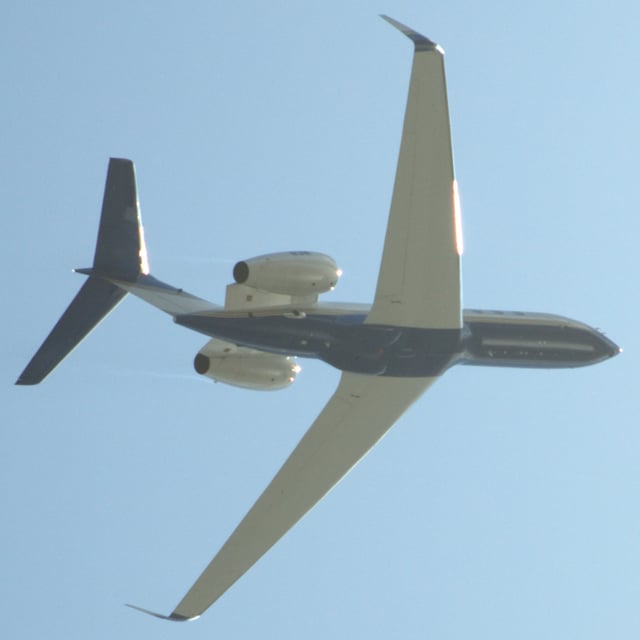
Viewed from below

front view
Data from HIAPER GV Brochure[18]
General characteristics
Crew: 2
Capacity: 15–19[19]
Length: 96.4 ft (29.4 m)
Wingspan: 93.45 ft (28.48 m)
Height: 26.85 ft (8.18 m)
Wing area: 1,137 sq ft (105.6 m2) [19]
Aspect ratio: 7.68
Empty weight: 46,200 lb (20,956 kg) , Basic Operating Weight with 4 crew : 46,800 pounds (21,228 kg)[19]
Max takeoff weight: 90,500 lb (41,050 kg)
Maximum Landing Weight : 75,300 pounds (34,200 kg)
Maximum Zero Fuel Weight : 54,500 pounds (24,700 kg)
Maximum Fuel Load : 41,300 pounds (18,700 kg)
Maximum Payload : 8,300 pounds (3,800 kg)
Payload w/ Max Fuel : 3,400 pounds (1,500 kg)
Cabin Length : 43.92 feet (13.39 m)
Cabin floor Width : 5.25 feet (1.60 m)
Cabin Height : 6.17 feet (1.88 m)
Powerplant: 2 × Rolls-Royce BR710A1-10 turbofan, 14,750 lbf (65.6 kN) thrust each [6]
Performance
Maximum speed: Mach 0.88,[2] long range cruise with 4 crew, 8 passengers[19]
Endurance: 14hr 28min[19]
Cruise speed : Mach 0.83 (882 km/h)
Normal cruise range : 5,500 nautical miles (10,186 km), with 5 crew, 12 passengers[3]
Takeoff MTOW, ISA, SL : 6,100 feet (1,900 m)
Climb rate : 4,188 feet per minute (21.28 m/s)[19]
See also
Related development
Gulfstream IV
Gulfstream G550
Aircraft of comparable role, configuration and era
Airbus Corporate Jets
Boeing Business Jet
Bombardier Global Express
Dassault Falcon 7X